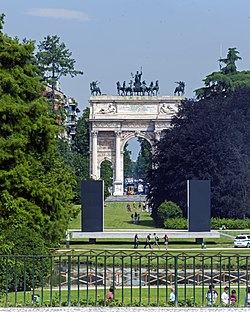Parco Sempione
show This article may be expanded with text translated from the corresponding article in Italian. (October 2016) Click [show] for important translation instructions. |
| Parco Sempione | |
|---|---|
 View through the park to the Arch of Peace from Piazza del Cannone, 2016 | |
 | |
| Type | Public |
| Location | Zone 1, Milan, Italy |
| Coordinates | 45°28′24.25″N 9°10′31.55″E / 45.4734028°N 9.1754306°ECoordinates: 45°28′24.25″N 9°10′31.55″E / 45.4734028°N 9.1754306°E |
| Area | 38.6 hectares (95 acres) |
| Created | 1888 |
| Operated by | Comune di Milano |
| Open | Opens 6:30 a.m. year round; closes 9 p.m. October–April, 9:30 p.m. in May and 10 p.m. June–September |
Parco Sempione ("Simplon Park") is a large city park in Milan, Italy. Established in 1888, it has an overall area of 38.6 hectares (95 acres), and it is located in the historic centre of the city, inside the Zone 1 administrative division.
The park is adjacent to the gardens of the Sforza Castle and to the Arch of Peace, two of the main landmarks of Milan. The very design of the park, due to architect Emilio Alemagna, was conceived with the intent of creating panoramic views encompassing both monuments. A third prominent monument of Parco Sempione is the Palazzo dell'Arte ("Palace of Art"), built in 1933 and designed by Giovanni Muzio, which currently houses the Triennale di Milano art expo.
In the park are Arena Civica, the public aquarium, and the Torre Branca tower. The X Triennial Pavilion (1954) has been converted into a public library.
History[]
The Sempione Park is located where the Visconti ducal park or "Barcho" was once located. Near the Sforzesco Castle, the park was enlarged and enclosed by the Sforza to become more than 3 million square meters in area. The park was a forest composed mainly of oaks and chestnut woods and inhabited by exotic animals introduced by members of the house of Sforza.[1]
With the fall of the Sforza and the Spanish occupation of Milan the park was abandoned and in 1861 was partly destined for agriculture. The area where the Sempione Park currently stands was instead used as a parade ground for the soldiers who were stationed near the Sforza Castle . The castle was used as a barracks, with consequent deterioration of the structures.[1]
During the Napoleonic era the architect Giovanni Antonio Antolini planned the construction of a large building complex around the castle, called "Foro Buonaparte" in honor of Napoleon;[2] the project was never realized, and in its place the parade ground was transformed into a large lawn for civic use, adorned on the north-eastern side by the Arena, and on the north-western side by the Arch of Peace, point of beginning of the axis of the Simplon.
After the unification of Italy, the military use of the area ceased,[3] and at the same time the city began to experience a demographic increase that required the construction of new neighborhoods. A real estate company proposed to redevelop the area of the castle (which was expected to be demolished) and the parade ground, similar to what was done in the area of the hospital, but the proposal caused strong protests from the citizenship of Milan. This led to the development of the committee established to draw up the first urban regulatory plan, developed up by the engineer Cesare Beruto (the Beruto Plan).[4] This plan, which initially partially incorporated the building ambits on the area, was modified several times to allocate the entire parade ground to a public garden. For the castle a restoration was planned, with the intention to create a destination for cultural uses.[5]
The park, called "Parco Sempione", was built between 1888 and 1894 according to the project of architect Emilio Alemagna,[6] which provided avenues for carriage, a pond and a belvedere where the Biblioteca del Parco Sempione currently stands. The green was designed according to the romantic model of the English parks.[7]
Toponymy[]
It owes its name to Corso Sempione, a major thoroughfare of Milan, dating back to the Napoleonic Empire.
Sculptures[]
The park hosts permanent sculptures by Arman, Francesco Barzaghi, Giorgio de Chirico and Antonio Paradiso. Teatro Continuo (1973), a prominent sculpture by Alberto Burri, was dismantled in 1989. It was restored and repositioned in its original location on the occasion of Expo 2015.
Communications[]
The whole area of the park is covered by a free wireless network.[8]

References[]
- ^ Jump up to: a b Informazione presa sui cartelloni informativi del parco
- ^ Pianta del progetto
- ^ Grandi, Pracchi, op. cit., p. 67
- ^ Grandi, Pracchi, op. cit., pp. 67-70
- ^ Grandi, Pracchi, op. cit., pp. 70-71
- ^ Grandi, Pracchi, op. cit., p. 79
- ^ Il Parco Sempione, comune.milano.it. URL consultato il 10 maggio 2013
- ^ A Milano wireless gratis per il Parco Sempione (in italian)
External links[]
 Media related to Parco Sempione (Milan) at Wikimedia Commons
Media related to Parco Sempione (Milan) at Wikimedia Commons- Official website (in Italian)
- Urban public parks
- Parks in Milan
- Tourist attractions in Milan
- World's fair sites in Milan
- 1888 establishments in Italy
